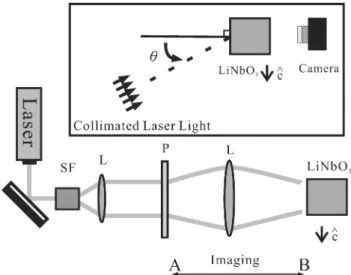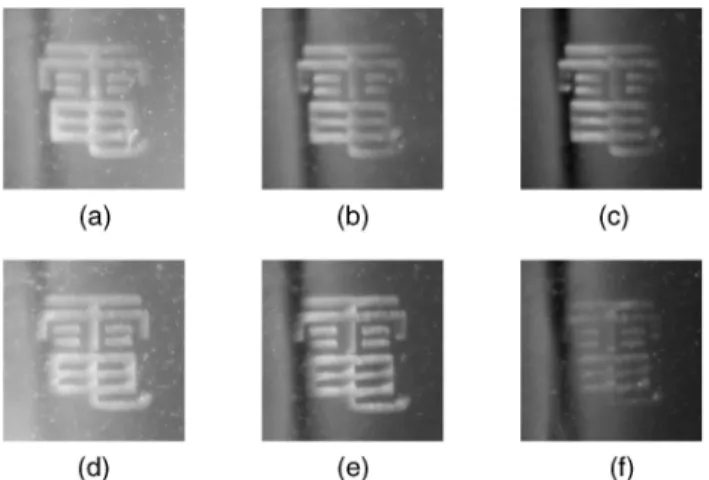February 1, 2005 / Vol. 30, No. 3 / OPTICS LETTERS 305
One-beam recording in a LiNbO
3
crystal
Jung-Ping Liu
Institute of Optical Sciences, National Central University, Chung-Li 320, Taiwan Hsiao-Yi Lee
Department of Optoelectronic System Engineering, Minghsin University of Technology, Hsinchu 304, Taiwan Hon-Fai Yau and Yin-Zhong Chen
Institute of Optical Sciences, National Central University, Chung-Li 320, Taiwan Chi-Ching Chang
Department of Applied Physics, Chung Cheng Institute of Technology, National Defense University, Taoyuen 335, Taiwan Ching Cherng Sun
Institute of Optical Sciences, National Central University, Chung-Li 320, Taiwan
Received July 1, 2004
We propose a new way to record images in a photorefractive LiNbO3 crystal. This method involves only a
single object light without any reference light. We believe that the recording is attained by fanning holograms that result from interference between the object light and its scattered light. Although volume gratings are involved, the recorded pattern can be viewed not only with a laser light beam that is incident over a certain angular range but also with white light. © 2005 Optical Society of America
OCIS codes: 050.7330, 090.2900, 160.3730, 190.5330, 210.0210.
Photorefractive LiNbO3crystals have been widely dis-cussed because of the distinguished performance in op-tical storage and other applications.1
In the standard process of recording information in a LiNbO3 crystal, a reference beam in addition to the object beam is needed to form an interference pattern. This pattern is recorded in the crystal via the photorefractive effect, and the object beam can be reconstructed only with the original reference beam. Although this holographic method can record the complete information on an ob-ject, it requires a light source of good coherence and relatively large space for attainment of interference. One-beam holographic recording was demonstrated by Kukhtarev et al.2
and Naruse et al.3
In the former case, Kukhtarev et al.2
demonstrated that the ordinary and extraordinary components of a single light beam could form interference gratings through the photo-voltaic effect in a BaTiO3crystal. In the latter case, Naruse et al.3
directed a light beam into a cubic crys-tal from one corner; the beam then automatically split into two beams that crossed each other in the crystal, and the object beam was recorded. In this Letter we propose an even simpler way to record a pattern in a LiNbO3 crystal directly without any reference beam. In contrast with the methods proposed by Kukhtarev
et al.2
and Naruse et al.3
, our method has no require-ment for the polarization state, the incident angle, or the incident position of the object beam, and thus it should be easier to implement.
The experimental setup is shown in Fig. 1. The storage medium is a 500-parts-in-106 photorefractive LiNbO3:Fe crystal of 20 mm 3 20 mm 3 20 mm size.
The c axis of the crystal is normal to the incident beam. The light source is a Verdi laser共l 苷 532.5 nm兲. The recording conf iguration is a 1:1 imaging system with the image plane inside the crystal. The input pat-tern (5 mm 3 5 mm in size) was first projected on the crystal with a collimated laser light of 50-mW兾cm2 intensity. The polarization state of the input light was set as extraordinarily polarized (e-polarized), and the exposure time was 10 min. It can also be set as
Fig. 1. Schematic of the setup in the recording stage: SF, spatial f ilter; Ls, lenses; P, input pattern. The diameter of the imaging lens is 5.4 cm, and its focal length is 32.5 cm. The inset is the schematic for reading; u is the angle of incidence of the reading beam.
February 1, 2005 / Vol. 30, No. 3 / OPTICS LETTERS 307
Fig. 3. Relation between the incident angle of the reading beam and the emerging angle of the diffracted beam ob-tained by calculation.
Fig. 4. Photos of the f inal images when a white-light lamp is used as the reading light source. Reading angles of (a) 5±, (b) 10±, (c) 15±, (d) 25±, (e) 210±, (f ) 215±.
Fig. 5. Demonstration of the spatial resolution with a U.S. Air Force resolution chart as the input pattern. (a) Image of the input pattern taken in plane B. In the recording stage the light source is a Verdi laser. (b) Final image obtained with a beam of white light.
the incident light without obstruction. Thus, looking from the back of the crystal, the part of the crystal where the fanning grating is located appears darker than its surroundings. Remember that the fanning grating spreads over the region where the image of
the object is located, and therefore a negative image of the object is observed.
The direction of the diffracted beam with respect to the direction of the reading beam can be estimated by use of the treatment proposed by Magnusson and Gay-lord.7
Results for three reading wavelengths (450, 532, and 650 nm) for the same recording wavelength at 532 nm are presented in Fig. 3. The incident angle of the reading beam is positive when the reading beam is below the crystal normal. The diffracted angle is positive when the reading beam is above the diffracted beam. All the angles here were measured inside the crystal, so they became larger outside. (The 15± inci-dence angle outside the crystal is an ⬃6.8± incidence angle inside the crystal). It can be seen from Fig. 3 that the diffracted angle for light at l苷 450 650 nm is practically the same when the incident angle is within 615± outside the crystal. This result implies that we can use white light to view an image, although this device actually employs volume gratings and the Bragg condition must be satisf ied. This expectation is confirmed by our experiment, and this observation is shown in Fig. 4. Comparing Fig. 4 with Fig. 2, one can see that white-light reading is superior to laser reading because in the former there is no speckle noise in the image. Finally, we have examined the resolution of this method. The resulting resolution is ⬃8 line pairs兾mm, as shown in Fig. 5.
In conclusion, we have experimentally demonstrated a method of recording images in a LiNbO3 crystal by use of the object beam alone. We believe that the recording is achieved by means of the photorefractive fanning effect. Accordingly, volume gratings take place in the bright region of the image, and one can exploit these volume gratings to yield the image of the object with white light as well as laser light.
The authors thank the National Science Council of the Republic of China for the support of this research (contract NSC-92-2215-E-008-017). Thanks are also due to W. H. Ip for his encouragement for the pub-lication of this work. J.-P. Liu’s e-mail address is jpliu@ios.ncu.edu.tw; H.-F. Yau’s e-mail address is yauhf@ios.ncu.edu.tw.
References
1. H. J. Coufal, D. Psaltis, and G. T. Sincerbox, eds.,
Holo-graphic Data Storage (Springer-Verlag, Berlin, 2000).
2. N. Kukhtarev, G. Dovgalenko, J. Galen, C. Duree, G. J. Salamo, E. J. Sharp, B. A. Wechsler, and M. B. Klein, Phys. Rev. Lett. 71, 4330 (1993).
3. S. Naruse, A. Shiratori, and M. Obara, Appl. Phys. Lett. 71, 4 (1997).
4. J. Feinberg, J. Opt. Soc. Am. 72, 46 (1982).
5. P. Yeh, Introduction to Photorefractive Nonlinear Optics (Wiley, New York, 1993).
6. M. Goulkov, S. Odoulov, J. Imbrock, M. Imlau, E. Krätzig, C. Bäumer, and H. Hesse, Phys. Rev. B 65, 195111 (2002).
7. R. Magnusson and T. K. Gaylord, Appl. Opt. 13, 1545 (1974).

